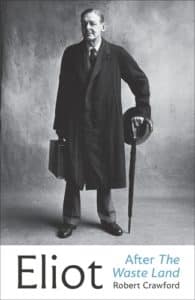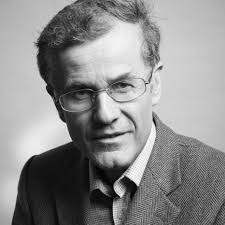Robert Crawford completes his biography of T.S. Eliot
After T.S. Eliot (1888-1965) published The Waste Land in 1922, it seemed that there might be a creative dry spell. As far as poetry was concerned, there was. He was struggling with his marriage and the declining mental health of his wife, Vivien; he was editing his literary magazine, Criterion; and he was maintaining a full-time job in banking. The next year, he transitioned from banker to editor at Faber & Gwyer (eventually to become Faber & Faber), where he stayed for the next four decades.
It is the second half of Eliot’s life, from 1923 to his death in 1965, that is the focus of Eliot After “The Waste Land” by British poet and writer Robert Crawford (I read the British edition; the American edition will be available Aug. 23). Crawford completed the first volume, The Young T.S. Eliot, in 2015. He’s completed the monumental biography seven years later, and, as he notes in the introduction, this biography has the benefit of the writer’s access to the extensive correspondence of Eliot and Emily Hale, his romantic interest for a considerable period of time. The letters were finally made available in 2020.

As World War II began, Eliot elected to remain in London. He also undertook the poetry sequence that became The Four Quartets: “East Coker,” “Burnt Norton,” “East Coker,” “The Dry Salvages,” and “Little Gidding.” Not only were the works broadly acclaimed; they’re also considered the finest war poems that emerged from World War II.
But with all of Eliot’s accomplishments, Crawford’s focus is Eliot the man. In fact, Crawford calls him “Tom” throughout the book. It is a deep, personal look that we get here; not only do we come to understand Eliot the poet but also Eliot the man, with his strengths and foibles, his triumphs and frustrations. It is the whole person who emerges from these pages, and the depth of Crawford’s research and understanding is more than apparent.

Robert Crawford
The author brings a wealth of research and understanding to the subject of Eliot. He is the Professor of Modern Scottish Literature at the University of St. Andrews, and a fellow of both the Royal Society of Edinburgh and the British Academy. He’s the author of The Savage and the City in the Work of T.S. Eliot (1991), as well as several works on Scottish literature, including Bannockburns: Scottish Independence and Literary Imagination 1314-2014, The Bard: Robert Burns, A Biography (2009), and Scotland’s Books: A History of Scottish Literature (2009). He is also a published poet, with six poetry collections, including Talkies (1992), Masculinity (1996), Spirit Machines (1999), Full Volume (2008), The Tip of My Tongue (2011), and Testament (2014).
Crawford tells the story of how Eliot heard the news that he’d been awarded the Nobel Prize for Literature, and it is very much an Eliot story. In early November of 1948, he was on a literary tour in the United States, when he received the news by telegram. His problem was that he would have to be in Stockholm for the ceremony on Nov. 10. It was a mad dash back to England (to pick up his tuxedo) and then on to Stockholm. It was an appropriate honor for the man who perhaps had more of an impact on 20th century literature and literary culture than any other single individual. But he was also somewhat rueful. “The Nobel is a ticket to one’s funeral,” he said. “No one has ever done anything after he got it.”
Eliot After “The Waste Land” is an achievement in itself. It is the best biography of Eliot ever written. Crawford understands the poet, and he understands the man, and he shares that understanding with the rest of us.
Related:
Robert Crawford on the Young T.S. Eliot
T.S. Eliot at the British Library, Part 1
T.S. Eliot at the British Library, Part 2
Princeton University Press has published W.H. Auden: Poems Vol. 1: 1927-1939 and Vol. II: 1940-1973. The collections were edited by Auden’s literary executor, Edward Mendelson. Combined, with annotations, footnotes, bibliography, and index, the two volumes are almost a total of 2,000 pages. Auden’s first publisher was T.S. Eliot.
Photo by cattan2011, Creative Commons, via Flickr. Post by Glynn Young.
How to Read a Poem uses images like the mouse, the hive, the switch (from the Billy Collins poem)—to guide readers into new ways of understanding poems. Anthology included.
“I require all our incoming poetry students—in the MFA I direct—to buy and read this book.”
—Jeanetta Calhoun Mish
- Poets and Poems: Paul Pastor and “The Locust Years” - June 26, 2025
- What Happened to the Fireside Poets? - June 24, 2025
- “What the House Knows”: An Anthology by Diane Lockward - June 19, 2025


Leave a Reply